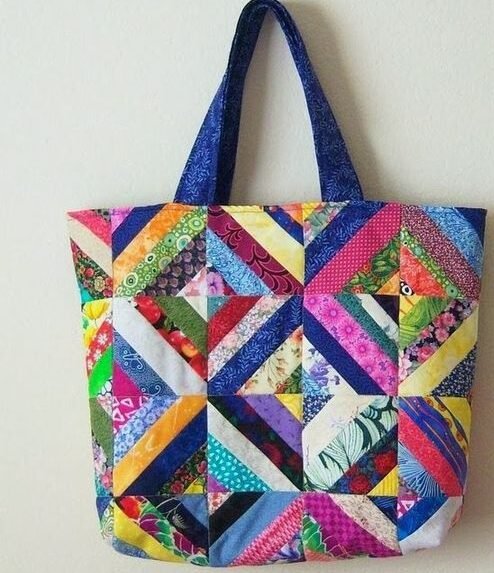If you’re a fan of intricate quilt patterns and love adding detailed designs to your quilting projects, the Tiny House Block is an ideal choice.
This quilt block combines creativity and precision to create a charming miniature house within your quilt.
In this tutorial, we’ll guide you through the steps to craft your own Tiny House Block using straightforward techniques and clear measurements. With the right materials and a little patience, you’ll master this fun and satisfying quilt pattern in no time.

Materials and Fabric Cutting for the Tiny House Block
Before starting, it’s essential to gather all the materials you’ll need. For the Tiny House Block, choose contrasting fabrics to define the house shape and background. You’ll need four different fabrics: one for the house, one for the roof, one for the door, and a fourth for the background. Keep in mind that color contrast is key to making each part of the block stand out.
Here are the fabric pieces and measurements you’ll need:
- Background fabric: Cut 2 squares of 4.5” x 4.5” for the sides and 2 rectangles of 2.5” x 5” for the top and bottom.
- House fabric: Cut a rectangle of 4” x 3” for the main structure.
- Roof fabric: Cut a triangle with a base of 4.5” and height of 2.5”.
- Door fabric: Cut a small rectangle of 1.5” x 2” for the door. By prepping your fabric cuts in advance, you’ll have everything ready for a smooth assembly process.
Constructing the House Base
To start the assembly, focus on the house structure. Take the 4” x 3” rectangle for the house fabric and align it with the background pieces. The background squares of 4.5” x 4.5” will go on the left and right sides of the house. Sew these pieces together with a quarter-inch seam allowance to maintain precision and keep the edges crisp.
Press the seams toward the house fabric after sewing to ensure everything lies flat. This is a crucial step, as neatly pressed seams help when you add more layers to the block. After sewing, you’ll start to see the tiny house form its foundation within the quilt block.
Next, sew the background rectangles (2.5” x 5”) to the top and bottom of the house structure. This frames the house and gives it a clean edge. The base of your Tiny House Block is now ready, and the next step will be constructing the roof to complete the look.
Assembling the Roof
Now, let’s focus on the roof. You’ll need to cut a triangle with a base of 4.5” and a height of 2.5” from the roof fabric. This piece will sit perfectly above the house, giving it the quintessential tiny house appearance. To add this piece, you’ll be sewing it between the top background pieces from earlier.
Start by aligning the triangle’s base with the top edge of the house structure. Make sure that both sides of the triangle extend evenly over the sides of the house to ensure symmetry. Use a quarter-inch seam allowance once again to sew the roof to the house. Press the seam open after sewing.
The triangle may look simple, but ensuring it fits smoothly can take a bit of patience. If the triangle doesn’t align perfectly on the first try, don’t worry. Adjust your placement until everything fits neatly. After the roof is added, you’ll have the full structure of the house ready to go.
Adding the Door and Final Details
To complete the Tiny House Block, it’s time to add the door. The door fabric is a small 1.5” x 2” rectangle that brings character to your quilt. Align the door piece in the center bottom part of the house and sew it directly onto the house fabric. You can choose to stitch around the edges or use applique techniques, depending on your style preference.
The door adds a delightful, whimsical detail to the block, making it feel more like a tiny home. If you prefer, you can add more embellishments, such as windows or chimneys, by using small squares or rectangles cut from different fabrics.
After adding the door, press the entire block once more to make sure all seams are flat. Trimming the edges of the block can help ensure everything is square and even, preparing the block for insertion into your larger quilt project.
SEE OTHER FACE PATTERNS HERE!
Final Tips for Completing the Tiny House Block
Now that you’ve completed your Tiny House Block, take some time to review the overall layout and ensure all seams are aligned. If necessary, make any adjustments by trimming or resewing to keep the block looking crisp. Since this quilt pattern is delicate and detailed, accuracy matters to maintain the block’s symmetry.
If you’re making multiple blocks to create an entire quilt, consider varying the fabrics and colors of each house to create a village-like appearance. Play with different roof shapes or window placements to add variety to your quilt while sticking to the Tiny House Block template.
Finally, always ensure that your quilt block is pressed flat before moving on to the next steps in your larger quilt project. Well-pressed blocks help with accurate sewing and contribute to the professional finish of your final quilt.
Incorporating the Tiny House Block Into a Quilt
Once you’ve mastered the Tiny House Block, the possibilities are endless. This quilt pattern is perfect for creating themed quilts or adding a unique flair to a larger project. You can incorporate the Tiny House Block into a modern quilt design by mixing it with other geometric blocks, or keep it traditional by using simple sashing to separate each block.
🌟 Join our exclusive Quilt broadcast list on Messenger! Receive the best patterns, tips, and updates directly in your inbox. Our team is ready to send you delightful content that will inspire your projects. Don’t miss this opportunity to stay updated and create amazing pieces. Join now and be part of this passionate quilt community! ✨📩
Tiny House Blocks are also ideal for storytelling quilts. For instance, each block can represent a different part of a town or neighborhood. Consider adding trees, roads, or even animals to make your quilt a true piece of art. Use color coordination to tie the blocks together or make them stand out as individual components.
To finish your quilt, decide on the size and layout that best suits your project. A quilt made entirely of Tiny House Blocks can be stunning, or you can mix it with other patterns to create a more diverse piece. Either way, this block will add charm and personality to any quilt design.
Conclusion
The Tiny House Block is a fun and engaging quilt pattern that brings creativity into every stitch. With its miniature house design, it offers plenty of opportunities to experiment with colors and layouts, making it a perfect addition to any quilt project. By following this step-by-step tutorial, you now have the skills to create your own Tiny House Block and incorporate it into a beautiful quilt.
Whether you’re a seasoned quilter or a beginner looking to try something new, the Tiny House Block is an excellent project that showcases your love for quilting. As you continue to explore new quilt patterns, remember that precision and creativity go hand-in-hand, allowing you to turn even the smallest blocks into a masterpiece. Happy quilting!




